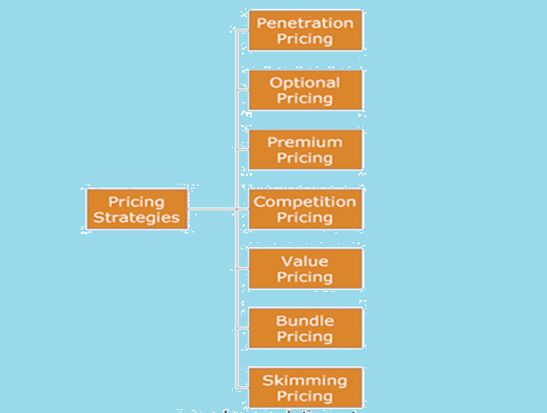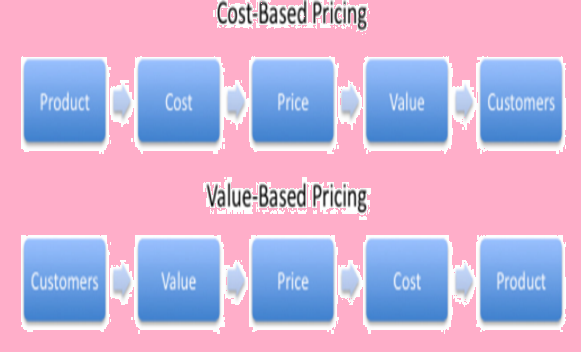Pricing Strategies
Pricing is a significant factor for financial growth of any company. Organizations develop numerous pricing strategies to market their products in order to attract consumers. Pricing strategy in marketing is the search of identifying the best price for a product. This strategy is combined with the other marketing standards which are recognized as the 4 P's (product, place, price, and promotion), market demand, product characteristics, competition, and economic patterns. The pricing strategy is major components of the marketing mix that produces revenues for the firm, while all the others are related to expenses (Finch et al., 1998). Price is the most flexible part of marketing strategy in that pricing decisions can be implemented consistently rapidly as compared to the other elements of marketing strategy. But Pricing decisions are complex. Though pricing of the company's marketing strategy is significant, there seems to be a lack of interest among marketing scholars.
Nagle and Holden (1995) stated that pricing is the most ignored component of the marketing mix. Internal and external factors influence decisions regarding the pricing of a product or service, therefore the pricing process involves a great deal of learning and observing. External factors, such as governmental regulations, cannot be influenced by the company. Instead, internal factors, such as the mission statement of a firm, are determined by the company itself. There are numerous factors taken into account in pricing strategy such as Fixed and variable costs, competition, company objectives, proposed positioning strategies, target group and willingness to pay.
Companies usually do not set a single price, but rather a pricing structure that reflects differences in geographical demand and costs, market-segment requirements, purchase timing, order levels, delivery frequency, guarantees, service contracts, and other factors. Consequently, despite of discounts, allowances, and promotional support, a company hardly realizes the same profit from each unit of a product that it sells. Pricing can be visualized as a process for all product lines or for each individual product. It is important to know the different relationships between sales volume and revenue, as well as competitors' prices and the costs to produce and promote a given product.
Price to profit ( Baker, 2003)

Pricing allows companies to either fit costs to prices or scrap products or services that cannot generate revenues for company. Normally, pricing policy is made on the fact that how a company sets the prices of its products and services based on costs, value, demand, and competition. Oxenfeldt (1983) affirmed that pricing objectives give directions for action. "To have them is to know what is expected and how the efficiency of the operations is to be measured" (Tzokas et al., 2000a).
An organization adopts various pricing objectives, but to get success, objectives of the company must go parallel with these strategies. Main pricing objectives in practice is target return and indicates that the company needs to accomplish a certain return on the overall sales. This objective is mainly used if the price is high and customers are not price sensitive. Penetration, is used to gain a market share, and companies may use economies of scale to attain this objective. Product-quality leadership is the objective that associates the price of a product with its brand and image. If the image of a brand is high, marketers can set a higher price by charging a premium (Sandhusen, 2008). The skimming objective is to set a high introduction price when a new product enters the market. It may be used if customers have intense desire for the product and they are willing to pay a premium price to get this product.
Numerous pricing strategies based on corporate strategies

Penetration Pricing: A penetration pricing strategy is intended to grab market share by entering the market with a low price relative to the competition to attract buyers. The main purpose is that the business will be able to raise awareness and get people to try the product. Even though penetration pricing may initially make a loss for the company, it will help to create This technique is a simple strategy for implementation because there are no sophisticated calculations and it leads to price peace. There is a difference between native and sophisticated going-rate pricing. Native means that the price is at the same level as that of competitors without taking into consideration costs and demand. Sophisticated going-rate pricing sets the price in a defined section in which the company consider certain degree conditions of demand and costs (Van Looy et al., 2003). word-of-mouth and awareness among a crowded market category. Penetration pricing needs thorough planning. It can result in fast diffusion and adoption. This strategy develops cost controls and cost reduction pressure from the beginning which results in good efficiency. Other benefits of this strategy is that it can produce high stock turnover through the distribution channel. Buy major limitation is that it establishes long term price expectations for the product and image to the brand and company. This makes difficult to increase price. Price penetration is suitable in conditions where product demand is high price elastic, substantial economies of scales are available, product is suitable for mass market.
Premium Pricing: Premium pricing strategy sets a price higher than the competitors. This strategy can be successfully used when there is something exclusive about the product or when the product is first to market and the business has a dissimilar competitive advantage. Premium pricing can be suitable for companies entering new to the market and maximize revenue at initial stages of the product life cycle.
Discount Pricing: Companies adopt discount pricing for product promotions in order to attract new customers. This discounted pricing draws attention to the product and can be used as a hook to bring in customers who will potentially purchase other items. This strategy is appropriate when seasonal changes in which company offers discounted prices of the items that are going out of season. The main advantages of this strategy are that it discounts to reward volume customers, repeat customers and employees develop customer loyalty. Loss leaders are effective for retailers who need to increase traffic in the store. Promotional discounts used carefully offer momentary advantages such as maximizing sales, income and profit. During a short-term discount period, more units are sold, allowing the company to reduce inventory and temporarily increase income. There are some disadvantages also such as consumer associate low price with low quality, particularly when the brand name is not aware. Discounted price strategy may lead to perception of poor quality.
Skim Pricing: Skim pricing is a procedure that companies adopt in launching new product. It is to find the best price point for a product, usually exceptional items with unidentified consumer demand. The price skimming strategy comprises of the company setting the primary product price high to rapidly cover embedded costs and then begins to gradually reduce the price to being the product to large market. The main objective of this strategy is to maximize potential profits until the optimum price is reached. The major benefits of this strategy are high profit margin, cost recovery, dealer's profit and quality image. Price skimming method has some limitations such as there is continual competitive pressure and cost inefficiency. Adopting this strategy enable to recover development cost through high profit margin.
Pricing Methods
There are numerous pricing techniques which are utilized in business field such as cost-based pricing, which is based on the costs incurred to develop the product, and competitive pricing, which involves basing prices on those charged by competitors (Wood, 1985). Cost-Based Pricing is most elementary pricing methods. The company adds a certain return to the unit costs (Kotler & Keller, 2006). A cost-based pricing approach may create hidden profits. Target-return pricing establishes the price according to a target-return on investment. Because the demand volume cannot be determined with absolute correctness, companies must recognize when they are at break-even, which is when the companies make no profit or loss (Hisrich, 2000). Value-Based Pricing differentiates itself from the methods of how a customer sees the value of a product or service. This approach focuses on the value seen by the customer instead of the cost incurred by the seller. Because the perceived value can vary over time, adjustments to and re-evaluations of the perceived value should be intermittently conducted (Baily et al., 2005). Value pricing inspires the customer to see that the price charged for the product or service is lower than the perceived quality (Balster, 2002). Value pricing can be high-low pricing, in which the store uses normal prices but offers regular promotions for the products (Brunn, 2006).
Difference between Cost based and value based pricing (Nagle & Holden, 2002)

Competition Pricing
This technique is a simple strategy for implementation because there are no sophisticated calculations and it leads to price peace. There is a difference between native and sophisticated going-rate pricing. Native means that the price is at the same level as that of competitors without taking into consideration costs and demand. Sophisticated going-rate pricing sets the price in a defined section in which the company consider certain degree conditions of demand and costs (Van Looy et al., 2003).
To summarize, the price is indispensable to generate revenue and profit, and suitable pricing guarantees that a company can compete in complex marketplace. Pricing is gaining significance in the current business world. In order to attract the buyers, company must set appropriate product prices and achieve profitability. Consumers usually do not buy products that are costly, Businesses employ different pricing strategies to offer products in the market and fulfil sales goal.

